

K-WANG


GE VMIPCI-5565 Ultrahigh Speed Fiber-Optic Reflective Memory with Interrupts
GE VMIPCI-5565 Ultrahigh Speed Fiber-Optic Reflective Memory with Interrupts
Product Overview
Basic information: VMIPCI-5565 is a PCI based reflective memory real-time fiber optic network product for GE Fanuc embedded systems, belonging to the VMIxxx-5565 series. It can be integrated into the network with other members of the series through standard fiber optic cables, and each board is called a node, allowing computers and other devices with different architectures and operating systems to share data in real time.
Key Features
A high-speed and easy-to-use fiber optic network with a serial rate of 2.12 Gbaud.
Supports PCI 64 bit 66MHz transmission, network operation does not require the involvement of a host processor.
Equipped with redundant operation mode, supporting up to 256 nodes.
The multi-mode fiber optic connection distance can reach up to 300 meters, and the packet size is dynamically variable (4-64 bytes).
The transmission rate varies depending on the packet size, with 47.1MB/s for 4-byte packets and 174MB/s for 64 byte packets.
Equipped with 64MB or 128MB SDRAM reflective memory with parity check, as well as two independent direct memory (DMA) channels, configurable byte order conversion to accommodate multiple CPU architectures on the same network.
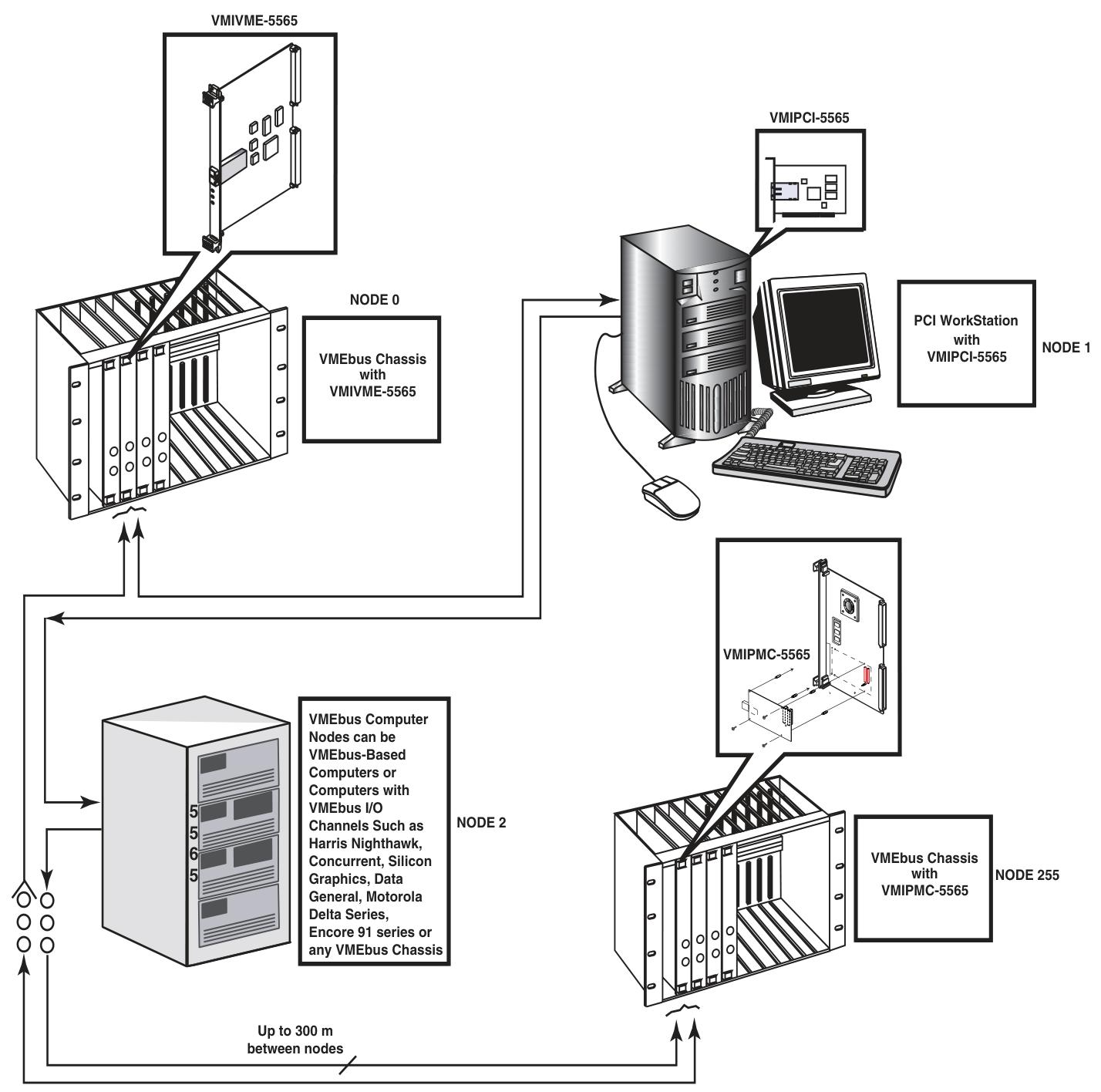
Operating principle
Basic operation: Each node in the network is interconnected in a daisy chain loop through fiber optic cables, and each node needs to have a unique node ID (set through 8 onboard jumpers). The data transmission is initiated by the PCI host system writing data to the onboard SDRAM. During the writing process, the onboard circuit automatically writes the data and related information into the transmit FIFO, forming variable length data packets that are transmitted through the fiber optic interface. The receiver opens the data packet and stores it in the receive FIFO, then writes it into the local SDRAM and routes it to its own transmit FIFO until the data returns to the source node and is removed.
Register group: including PCI configuration registers, local configuration registers, runtime registers, DMA control registers, reflective memory (RFM) control and status registers. The functions and purposes of each register group are different, and some registers have different initialization methods and modification frequencies.
Reflective memory RAM: There are two specifications, 64MB or 128MB, with parity check. The starting position is specified by the base address register 3. The parity check function needs to be enabled by setting a specific register, and write operations need to be performed at the 32-bit or 64 bit boundary.
Interrupt circuit: There is a single PCI interrupt output (INTA #), and the interrupt source can be enabled and monitored separately through multiple registers. The interrupt circuit is divided into two layers, and the second layer interrupt is transmitted to the first layer through the LINTi # signal.
Redundant transmission mode: Removing the jumper blades between pins 1-2 of jumper E7 can configure it as redundant mode. At this time, each data packet is transmitted twice, and the receiving circuit evaluates the transmission situation. Although this mode reduces the probability of data loss, it will also lower the effective network transmission rate.
**Rogue packet removal operation * *: Rogue packets are packets that do not belong to any node in the network. VMIPCI-5565 can run as one of the two Rogue hosts to detect and remove rogue packets. After detection, relevant flags will be set and PCI interrupts can be triggered.
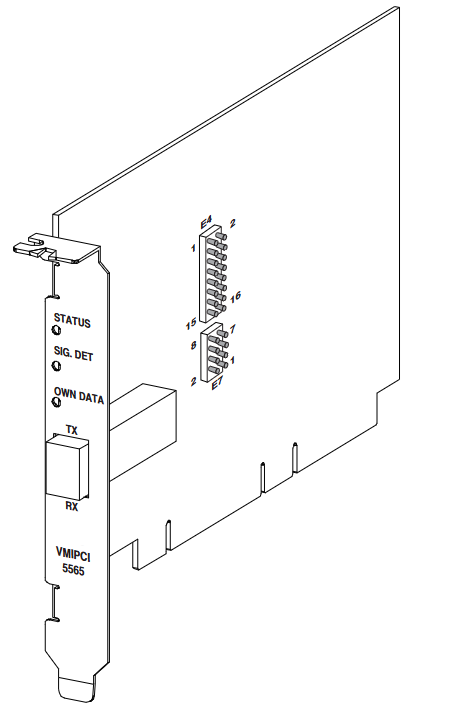
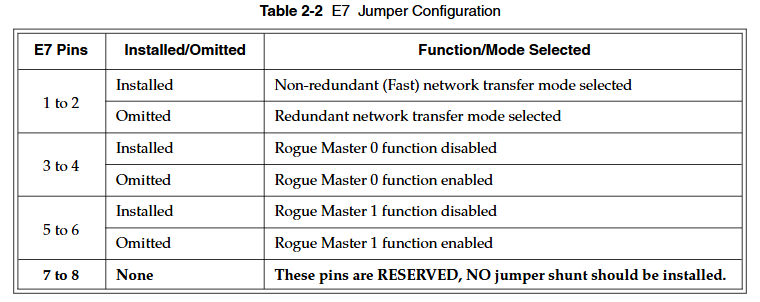
Configuration and Installation
Unpacking procedure: Components are sensitive to static electricity and should be handled on conductive materials. When not in use, they should be stored in their original packaging. Upon receipt, they should be inspected for any transportation damage and claims should be promptly processed.
Jumper configuration and position
The node ID is set by the 8 jumper blades of jumper block E4, and each node ID needs to be unique. Install the jumper blade so that the corresponding bit is low (0), and remove it so that it is high (1).
Jumper E7 controls three functions: 1-2 pins select non redundant or redundant network transmission mode, 3-4 pins enable or disable rogue host 0 function, 5-6 pins enable or disable rogue host 1 function, 7-8 pins are reserved pins and should not be installed with jumper blades. The default configuration is to install jumper blades on all pins except 7-8.
Physical installation: Before installation, it is necessary to ensure that the node ID and operation mode have been set. Power off the installation, firmly insert the board into the PCI connector and fix the screws, then reinstall the chassis cover and turn on the power. The board design complies with the PCI 2.2 specification.
Front panel description: There are three LED indicator lights, the red status LED is user-defined, and it is on by default when turned on. The status can be switched by writing to bit 31 of the control and status registers; The yellow signal detection LED lights up when the receiver detects light; The green self data LED lights up when it detects the return of its own data. There are also "RX" receiver ports and "TX" transmitter ports, which use "LC" type fiber optic cables. Dust caps should be installed when not connected to the cables, and eye injuries should be avoided when not powered.
Cable configuration: Provides cable specifications and connector specifications for multimode or single-mode fiber optic interfaces, including core diameter, cladding diameter, sheath outer diameter, attenuation, bandwidth, and other parameters, as well as connector compatibility, insertion loss, and other information.
Connectivity: Nodes are connected in a circular manner, as in the example of a circular connection of six nodes.
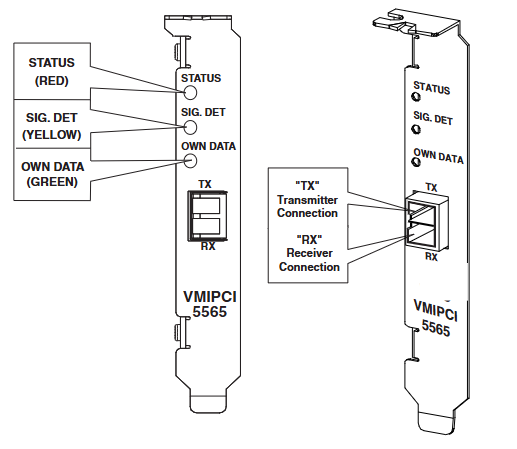
Programming
PCI configuration register: located in the 256 bytes of the PCI configuration space, the first 64 bytes are predefined headers that contain information such as vendor ID and device ID. Some registers can be modified by the user, while others are read-only or initialized by the system BIOS.
Local configuration registers: can be accessed through base address register offset 0 or 1, initialized to normal working configuration by serial EEPROM, and some registers can be modified by users to match the host system.
Runtime register: It is also accessed through the base address register offset 0 or 1, and will not be initialized by the serial EEPROM, maintaining the default state when the PCI bus is reset. Users need to modify some bits to activate the desired operating mode.
DMA control register: accessed through offset 0 or 1 of the base address register, it defaults to the PCI reset state and needs to be modified by the user to activate the operating mode, including DMA channel mode register, address register, etc., used to operate two DMA engines.
RFM control and status register: located in PLX local address space 0, the base address is specified by "PCI base address 2" in the PCI configuration register, including board revision register, node ID register, etc., to achieve the unique function of reflecting the memory board.
DMA operation example: It is necessary to find the value of the base address register 0, set five DMA registers, and then start the transfer and monitor the completion status by writing to the command/status register.
Example of network interrupt handling: including setting steps (clearing previous interrupts in FIFO, setting relevant registers to enable interrupts, etc.) and steps for serving network interrupts (reading registers to determine interrupt source, processing data and sender ID, etc.).
Maintain and comply with information
Maintenance: When the product malfunctions, it is necessary to first check the software, system configuration, electrical connections, etc. If a return is required, please contact GE Fanuc Embedded Systems to obtain a Return Merchandise Authorization (RMA) number. User level repairs are not recommended, and the drawings and charts in the manual are for reference only.
Compliance information: Complies with multiple international standards and regulations, such as the EU's EN series standards, the US FCC Part 15, and Australia/New Zealand's AS/NZS CISPR 22. Compliance requirements and restrictions vary in different regions.
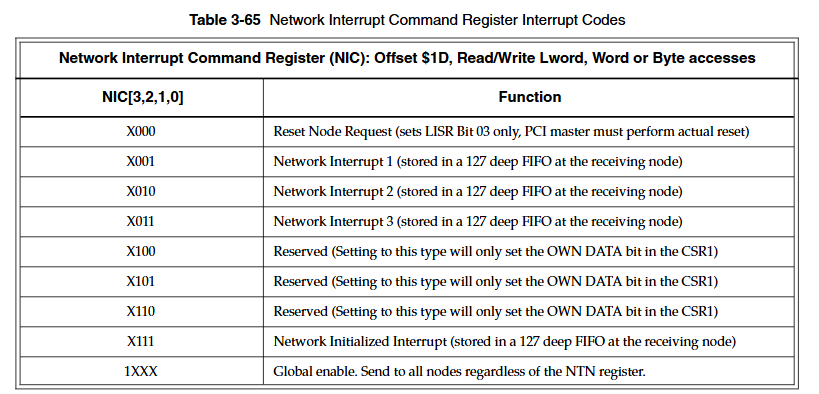
- YOKOGAWA
- Energy Access
- Renewable Integration
- Energy Subsidies
- Energy and Water
- Net zero emission
- Energy Security
- Critical Minerals
- A-B
- petroleum
- Mine scale
- Energy and Gender
- Covid-19
- man-machine
- Reliance
- ADVANCED
- SEW
- ProSoft
- WATLOW
- Kongsberg
- FANUC
- VSD
- DCS
- PLC
- Sewage treatment
- cement
- Yaskawa
- Woodward
- BOSCH Rexroth
- MOOG
- General Electric
- American NI
- Rolls-Royce
- CTI
- Honeywell
- EMERSON
- xYCOM
- Construction site
- Siemens
- architecture
- Industrial information
- New energy
- Automobile market
- electricity
- Motorola
- HIMA
- ABB
- Rockwell
- Schneider Modicon
- MAN
- GE
- TRICONEX
- Control Wave
- ALSTOM
- AMAT
- STUDER
- KONGSBERG
- MOTOROLA
- DANAHER MOTION
- Bentley
- Galil
- EATON
- MOLEX
- Triconex
- DEIF
- B&W
- ZYGO
- Aerotech
- DANFOSS
- KOLLMORGEN
- Beijer
- Endress+Hauser
- schneider
- Foxboro
- KB
- REXROTH
-
Kollmorgen S33GNNA-RNNM-00 - Brushless Servo Motor
-
Kollmorgen 6sm56-s3000-g-s3-1325 - Servo Motor
-
Kollmorgen AKM52K-CCCN2-00 - Servo Motor
-
Kollmorgen PSR3-230/75-21-202 - Power Supply
-
Kollmorgen akm24d-anc2r-00 - Servo Motor
-
Kollmorgen AKM22E-ANCNR-00 - Servo Motor
-
Kollmorgen S60300-550 - Servo Drive
-
Kollmorgen B-204-B-21 - Servomotor
-
Kollmorgen AKM21E-BNBN1-00 - Servo Motor
-
Kollmorgen TT2953-1010-B - DC Servo Motor
-
Kollmorgen pa8500 - Servo Power Supply
-
Kollmorgen BDS4A-210J-0001-207C2 - Servo Drive
-
Kollmorgen TTRB1-4234-3064-AA - DC Servo Motor
-
Kollmorgen MH-827-A-43 - Servo Motor
-
Kollmorgen AKM24D-ACBNR-OO - Servo Motor
-
Kollmorgen 00-01207-002 - Servo Disk DC Motor
-
Kollmorgen AKM21C-ANBNAB-00 - Servo Motor
-
Kollmorgen PSR3-208/50-01-003 - Power Supply
-
Kollmorgen 6SM56-S3000 - Servo Motor
-
Kollmorgen DBL3H00130-B3M-000-S40 - Servo Motor
-
Kollmorgen 6SN37L-4000 - Servo Motor
-
Kollmorgen AKM65K-ACCNR-00 - Servo motor
-
Kollmorgen 6SM56-L3000-G - Servo Motor
-
Kollmorgen AKMH43H-CCCNRE5K - Servo Motor
-
Kollmorgen PSR4/52858300 - Power Supply
-
Kollmorgen KBM-79H03-E03 - Direct Drive Rotary Motor
-
Kollmorgen AKM33E-ANCNDA00 - Servo Motor
-
Kollmorgen U9M4/9FA4T/M23 - ServoDisc DC Motor
-
Kollmorgen AKM13C-ANCNR-00 - Servo Motor
-
Kollmorgen AKM43L-ACD2CA00 - Servo Motor
-
Kollmorgen AKM54K-CCCN2-00 - Servo Motor
-
Kollmorgen M-605-B-B1-B3 - Servo Motor
-
Kollmorgen AKD-P00606-NBAN-0000 - Rotary Drive
-
Kollmorgen 6SM-37M-6.000 - Servo Motor
-
Kollmorgen A.F.031.5 - Sercos Interface Board
-
Kollmorgen 918974 5054 - Servo PWM
-
Kollmorgen U12M4 - ServoDisc DC Motor
-
Kollmorgen AKD-B00606-NBAN-0000 - Servo Drive
-
Kollmorgen MV65WKS-CE310/22PB - Servo Drive
-
Kollmorgen 65WKS-CE310/22PB - Servo Drive
-
Kollmorgen EM10-27 - Module
-
Kollmorgen S64001 - Servo Drive
-
Kollmorgen CR03200-000000 - Servo Drive
-
Kollmorgen 6SM57M-3000+G - Servo Motor
-
Kollmorgen BDS4 - Servo Drive
-
Kollmorgen AKD-P00306-NBEC-000 - Servo Drive
-
Kollmorgen AKD-B01206-NBAN-0000 - Servo Drive
-
Kollmorgen STP-57D301 - Stepper Motor
-
Kollmorgen 6SM37L-4.000 - Servo Motor
-
Kollmorgen 44-10193-001 - Circuit Board
-
Kollmorgen PRDR9SP24SHA-12 - Board
-
Kollmorgen PRD-AMPE25EA-00 - Servo Drive
-
Kollmorgen DBL3N00130-0R2-000-S40 - Servo Motor
-
Kollmorgen S406BA-SE - Servo Drive
-
Kollmorgen AKD-P00607-NBEI-0000 - Servo Drive
-
Kollmorgen AKD-P01207-NBEC-0000 - Servo Drive
-
Kollmorgen CR03550 - Servo Drive
-
Kollmorgen VSA24-0012/1804J-20-042E - Servo Drive
-
Kollmorgen N2-AKM23D-B2C-10L-5B-4-MF1-FT1E-C0 - Actuator
-
Kollmorgen 04S-M60/12-PB - Servo Drive
-
Kollmorgen H33NLHP-LNW-NS50 - Stepper Motor
-
Kollmorgen A-78771 - Interlock Board
-
Kollmorgen AKM43E-SSSSS-06 - Servo Motor
-
Kollmorgen AKD-P00607-NBEC-0000 - Servo Drive
-
Kollmorgen E21NCHT-LNN-NS-00 - Stepper Motor
-
Kollmorgen cr10704 - Servo Drive
-
Kollmorgen d101a-93-1215-001 - Motor
-
Kollmorgen BDS4A-203J-0001-EB202B21P - Servo Drive
-
Kollmorgen MCSS23-6432-002 - Connector
-
Kollmorgen AKD-P01207-NACC-D065 - Servo Drive
-
Kollmorgen CK-S200-IP-AC-TB - I/O Adapter and Connector
-
Kollmorgen CR10260 - Servo Drive
-
Kollmorgen EC3-AKM42G-C2R-70-04A-200-MP2-FC2-C0 - Actuator
-
Kollmorgen BDS5A-206-01010-205B2-030 - Servo Drive
-
Kollmorgen s2350-vts - Servo Drive
-
Kollmorgen AKM24D-ANC2DB-00 - Servo Motor
-
Kollmorgen E31NCHT-LNN-NS-01 - Stepper Motor
-
Kollmorgen PRD-0051AMPF-Y0 - Servo Board
-
Kollmorgen TB03500 - Module
-
Kollmorgen 60WKS-M240/06-PB - Servo Drive
-
Kollmorgen M21NRXC-LNN-NS-00 - Stepper Motor
-
Kollmorgen H-344H-0212 - Servo Motor
-
Kollmorgen MCSS08-3232-001 - Connector
-
Kollmorgen AKM33H-ANCNC-00 - Servo Motor
-
Kollmorgen PA-2800 - Power Supply
-
Kollmorgen MTC308C1-R1C1 - Servo Motor
-
Kollmorgen PRDR0091300Z-00 - Capacitor Board
-
Kollmorgen BDS4A-206J-0024/01502D79 - Servo Drive
-
Kollmorgen S20330-VTS - Servo Drive
-
Kollmorgen S20250-CNS - Servo Drive
-
Kollmorgen SBD2-20-1105-WO - Servo Drive Board
-
Kollmorgen M405-C-A1--E1 - Servo Motor
-
Kollmorgen PRD-PB805EDD-00 - Servo Drive
-
Kollmorgen 6SM57S-3.000-J-09-HA-IN - Servo Motor
-
Kollmorgen AKM33H-ANCNDA-00 - Servo Motor
-
Kollmorgen PCB-00030200-04 - PCB
-
Kollmorgen H22SSLB-LNN-NS-02 - Stepper Motor
-
Kollmorgen BJRL-20012-110001 - Module
-
Kollmorgen BDS4A-206J-0001404A - Servo Drive
-
Kollmorgen H-342-H-0802 - Servo Motor
-
Kollmorgen CR10561 - Servo Drive
-
Kollmorgen BDS5A-206-00010-205B2-030 - Servo Drive
-
Kollmorgen BDS5A-206-00010-207B-2-030 - Servo Drive
-
Kollmorgen mcss08-3224-001 - Connector
-
Kollmorgen M-207-B-23-B3 - Servo Motor
-
Kollmorgen PRD-0041200Z-S0 - Encoder/Resolver Card
-
Kollmorgen MH-225-G-61 - Motor
-
Kollmorgen MT308B1-T1C1 - Servo Motor
-
Kollmorgen BDS4A-240J-0001604C83 - Servo Drive
-
Kollmorgen 6SM57-S-3000 - Servo Motor
-
Kollmorgen N-T31V-15-5B-6-MF3-FT1E-C251 - Actuator
-
Kollmorgen PRD-0051AMPA-X0 - Servo Board
-
Kollmorgen CF-SS-RHGE-09 - Cable
-
Kollmorgen DIGIFAS7204 - Servo Drive
-
Kollmorgen S30101-NA - Servo Drive
-
Kollmorgen DIGIFAS7201 - Servo Drive
-
Kollmorgen PRD-0051AMPA-Y0 - Servo Board
-
Kollmorgen AKM23D-EFCNC-00 - Servo Motor
-
Kollmorgen SE10000 - Servo Drive
-
Kollmorgen PSR4/5A-112-0400 - Power Supply
-
Kollmorgen AKM31H-ANCNC-01 - Servo Motor
-
Kollmorgen M-203-B-93-027 - Servo Motor
-
Kollmorgen CP-SS-G1HE-05 - Connector
-
Kollmorgen AKM42G-ASCNR-02 - Servo Motor
-
Kollmorgen DBL4N00750-B3M-000-S40 - Servo Motor
-
Kollmorgen R3-BK23-152B-12-PL-ASE-BS115 - Actuator
-
Kollmorgen MH-427-B-61 - Motor
-
Kollmorgen cr06902 - Servo Drive




